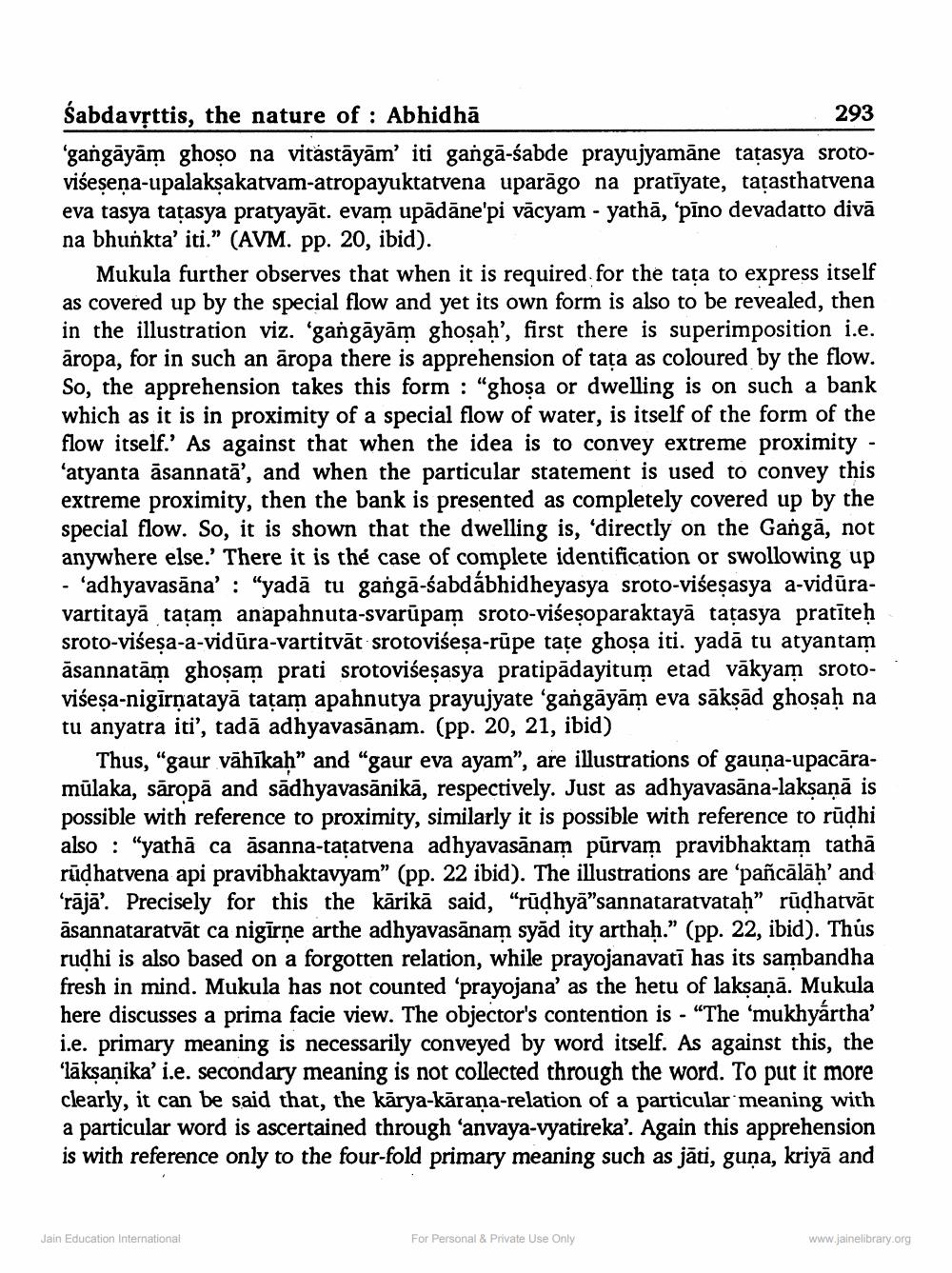________________
Śabdavṛttis, the nature of : Abhidhā
293 'gangāyām ghoso na vitástāyām' iti gangā-sabde prayujyamāne tatasya srotovišeşeņa-upalaksakatvam-atropayuktatvena uparāgo na pratīyate, taţasthatvena eva tasya tatasya pratyayāt. evam upādāne'pi vacyam - yathā, 'pīno devadatto divā na bhunkta' iti.” (AVM. pp. 20, ibid).
Mukula further observes that when it is required for the taţa to express itself as covered up by the special flow and yet its own form is also to be revealed, then in the illustration viz. 'gangāyām ghosah', first there is superimposition i.e. āropa, for in such an āropa there is apprehension of taţa as coloured by the flow. So, the apprehension takes this form : "ghosa or dwelling is on such a bank which as it is in proximity of a special flow of water, is itself of the form of the flow itself.' As against that when the idea is to convey extreme proximity - ‘atyanta āsannatā', and when the particular statement is used to convey this extreme proximity, then the bank is presented as completely covered up by the special flow. So, it is shown that the dwelling is, 'directly on the Gangā, not anywhere else.' There it is the case of complete identification or swollowing up - 'adhyavasāna' : "yadā tu gangā-śabdábhidheyasya sroto-višeşasya a-vidūravartitayā taţam anapahnuta-svarūpam sroto-višeşoparaktayā tatasya pratīteh sroto-višeşa-a-vidūra-vartitvāt srotovićeşa-rūpe tate ghosa iti. yadā tu atyantam āsannatām ghosam prati srotovišeșasya pratipādayitum etad vākyam srotovišeșa-nigirmatayā tatam apahnutya prayujyate 'gangāyām eva sākṣād ghosah na tu anyatra iti', tadā adhyavasānam. (pp. 20, 21, ibid)
Thus, "gaur vāhīkah" and "gaur eva ayam", are illustrations of gauna-upacāramülaka, sāropā and sādhyavasānikā, respectively. Just as adhyavasāna-lakṣaṇā is possible with reference to proximity, similarly it is possible with reference to rūdhi also : "yathā ca asanna-tatatvena adhyavasānam pūrvam pravibhaktam ta rūdhatvena api pravibhaktavyam” (pp. 22 ibid). The illustrations are 'pañcālāh' and 'rājā'. Precisely for this the kārikā said, "rūdhyā"sannataratvatah” rūdhatvāt āsannataratvāt ca nigīrne arthe adhyavasānam syād ity arthaḥ.” (pp. 22, ibid). Thús rudhi is also based on a forgotten relation, while prayojanavati has its sambandha fresh in mind. Mukula has not counted 'prayojana' as the hetu of laksaņā. Mukula here discusses a prima facie view. The objector's contention is - "The 'mukhyártha' i.e. primary meaning is necessarily conveyed by word itself. As against this, the 'laksanika' i.e. secondary meaning is not collected through the word. To put it more clearly, it can be said that, the kārya-kārana-relation of a particular meaning with a particular word is ascertained through 'anvaya-vyatireka'. Again this apprehension is with reference only to the four-fold primary meaning such as jāti, guna, kriyā and
Jain Education International
For Personal & Private Use Only
www.jainelibrary.org




